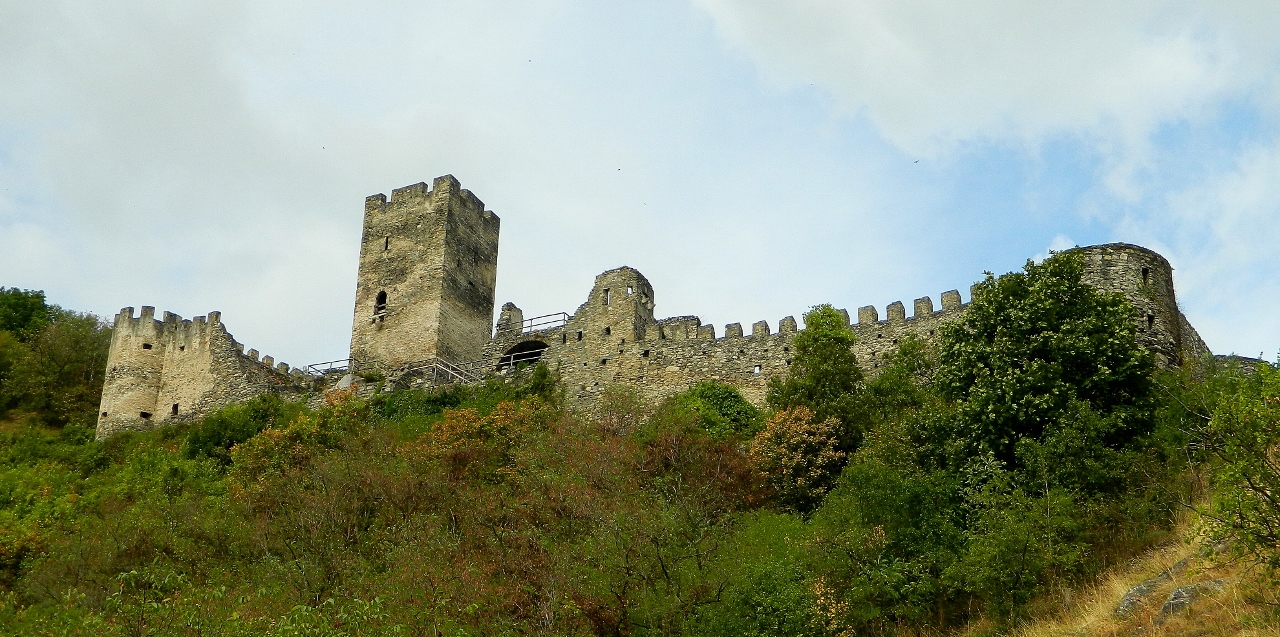The Wachau Valley is considered the most beautiful stretch of the Danube in lower Austria. It has a particularly mild and localised climate that lends itself to growing grapes for wine, and apricots or ‘marillen’ for liquors, preserves and cakes.

At Spitz, we hiked up the steep hillside to a classic stone castle, and then climbed up its cobbled streets, stone steps and finally a rickety wooden staircase to the top of the watchtower over the crenelated embattlements. The view of the valley and the silvery green river in the mid-morning sun was enchanting and worth the slithery 200 metre steep descent back downhill to the riverboat crossing.
We had planned to cross the river but decided against taking Bertha onto the narrow jetty and continued on the north bank of the river to the wine growing village of Weissenkirchen.
Its gothic church has a covered wooden stairway that leads up through massive fortified walls. The church is grimly baroque inside with oppressive black, gold and red marble sculptures of the crucifixion and martyred saints.
More appealingly, in the centre of the village is the Teisenhoferhof, a sixteenth century fortified farm with an arcaded courtyard and a decorated covered gallery. It was setting up for the annual theatre production.
A makeshift stage and seating was already arranged and an anxious-looking chap was trying to book a pair of highly prized seats already reserved for someone else. We shared a joke with the woman manning the ‘box office’ and holding firm. She gifted us a small book showing paintings of nineteenth and early twentieth century life in the Wachau Valley, a charming gesture which we both appreciated when poring over the pages later.
We crossed the river to our aire at Rossatz, another wine village and with views of Durnstein, ‘the pearl of the Danube’ on the opposite bank. The lovely fortress village is known for its distinctive baroque and blue and white clock tower and for being the setting of the imprisonment of King Richard I (the Lionheart) on his way home to England from the crusades. From Bertha’s picture window that night we had a perfect view of the ruined and atmospheric castle which was lit up once darkness fell on the vine-covered and forested slopes below and above it.
Rains started in the early hours and the morning was cool and misty so it was lunchtime before we ventured out on our bikes and into Krems and Stein, neighbouring towns more than one thousand years old. Actually we were underwhelmed by the architecture which didn’t have the charm of the villages but we both enjoyed being in a bustling centre for a rare lunch out, bizarrely in a Swahili café.
Fortified on piping hot ragu and poached eggs, we walked around the medieval stone walls and cobbled streets to find the oldest and original purveyors of ‘marillen’ treats, before heading out onto the fast Donauradweg amongst packs of aggressive lycra-clad cyclists.
I was grateful when Simon chose to stop at a wine sellers’, simply to get off the bike, but once inside we had an informative and enjoyable wine tasting with charming and knowledgeable Lucas. Cycling on through the vineyards we put our new understanding to the test by picking out the varietals and vintages exclusive to the Wachau Valley.
Needing to cross the river back to Rossatz we cycled through Durnstein (not as pretty close up) and were treated to a private crossing on the river boat to St Loretz. The current of the Donau was frighteningly strong and the small flat bottomed ferry crossed by virtue of a steel cable pulling the boat along from overhead. Back on the north side, vineyards gave way to acres of fruit trees rich with pickings of plums, apricots, apples and pears. It seemed appropriate to stop at our local weingut for a glass of Grunner Veltliner and to toast a truly lovely stretch of Austria.

